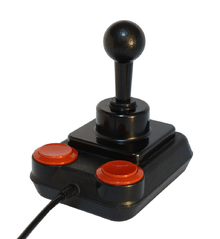Kempston Micro Electronics
Kempston Micro Electronics was an electronics company specialising in computer joysticks and related home computer peripherals during the 1980s. Kempston was based in Kempston, Bedfordshire, England.
Interfaces

- Main article: Kempston Interface
Kempston produced a number of joystick interfaces for the Sinclair ZX Spectrum to allow normal Atari-style DE-9 connector joysticks to be used with it. Apart from implementing existing joystick interfacing modes they produced their own standard which delivered the joystick state on the Z80 bus at port 31 (read in BASIC using IN 31). This meant that the joystick did not produce key-presses like the other standards and the method was soon borrowed by other interface manufacturers and became quite popular.
Mouse
- x-axis at port 64479
- y-axis at port 65503
- two buttons at port 64223
Joysticks
The first Kempston joysticks sold were cheap springless ones for a Phillips Video Game console sold by Voltmace Ltd. Voltmace made the first circuit boards for the interface too.
Formula 1 and 2
The Formula 1 was based on the Quickshot 1 and released June 1985 at £16.95. Its successor, the Formula 2, featured three fire buttons, two on the base and one on the top, and was released June 1985 at £11.95.
Score Board
Features a base similar in size to a 48K Spectrum, with two fire buttons. Released June 1985 at £28.95
Pro 3000
A cheap joystick with two buttons on the stick (one on the top and one at the front) and one on the base of the joystick, in front of the stick. Eight-way rugged leaf-switches were used to register the joystick movements.
Competition Pro

It consisted of a square base, two large red buttons (for left or right-handed use) and a black pommel stick. It used the Atari 2600 standard DE-9 connector and was primary designed to work with the ZX Spectrum Kempston joystick interface but also with the compatible ports built into other home computers such as the Amstrad CPC, Commodore 64 (& VIC-20) and later Commodore Amiga and Atari ST.
Internally the joystick used a series of metal contacts to signal movement to the computer. When the user applied pressure to one side of the stick it caused the two contacts to touch and form a circuit, commonly referred to as a leaf switch. This meant that it was easily repaired by unscrewing the base and adjusting the metal contacts so they touched correctly. Later joysticks such as the Competition Pro 5000 used micro-switches instead.
It attracted its fair share of imitators on 8-bit computers who copied the colour scheme (itself somewhat derived from the original Atari joystick), but also more brazen copies which used yellow, square buttons or microswitches but essentially the same pommel design, such as the Zip Stick.
The design has been honoured most recently by the C64 Direct-to-TV device which fits an entire Commodore 64 and 30 games into the shell of a Competition Pro lookalike case which runs off batteries. USB and Retro DE-9 versions of the Competition Pro with two extra tactile fire buttons on the base are now manufactured by German company SPEED-Link.
Competition Pro Xtra
Based on the Competition Pro 5000, this design saw micro-switches replace the leaf switches in every direction and the two fire buttons.
This joystick was always actually produced by a company called Dynamics Marketing, which later became a subsidiary of Powerplay Ltd, a subsidiary of Delph Manufacturing Services (Delph Tool Co Ltd), the company that manufactured the Competition Pro range through its lifetime, and the same company which manufactured, and later also marketed the Zipstick joystick along with Cruiser and Sureshot products too.
Powerplay continued to manufacture video game accessories under the brand of Competition Pro.